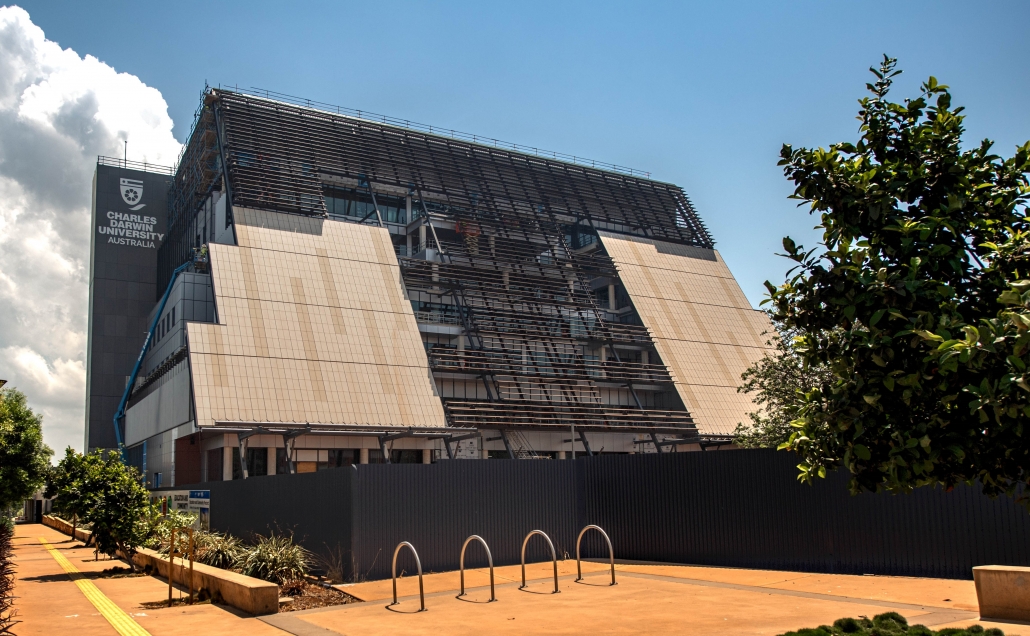CDU’s city campus stays cool under Darwin heat

The façade of Charles Darwin University’s (CDU) new city campus is complete ahead of the wet season, capping off the building’s main protection against Darwin’s tropical heat and humidity.
Standing 40 metres tall, with a combination of vertical and sloping design features, the building includes curtain wall with porcelain tiles, horizontal aluminium louvres, and various types of cladding to reflect the harsh Darwin weather, while ensuring the iconic Boab tree is not overshadowed.
The milestone joins other achievements at the Education and Community Precinct, also known by the Larrakia name Danala, including disassembling the two cranes and sealing the building against the elements.
The Australian Government has contributed $97.3 million to the $250 million campus project, which is the centrepiece of the Darwin City Deal.
Construction of the city campus was also funded by the Northern Australia Infrastructure Facility (NAIF), with a $151.5 million NAIF loan supporting the University’s growth.
Federal Minister for Infrastructure, Transport, Regional Development and Local Government Catherine King said the new campus would be a cornerstone of future innovation and education, while also contributing to the economic growth of the Territory.
“The infrastructure we are delivering today will play a key role in the Territory of tomorrow – especially with this environmental design protecting the façade of Charles Darwin University’s new city campus from the harsh Darwin tropical heat and humidity,” Ms King said.
“The Australian Government is pleased to be delivering this project in this impressive new precinct that will bolster the territory’s economy for years to come.”
The façade is primarily made of porcelain cladding, which is engineered to endure – it is non-combustible, absorbs minimal water, resists high wind loads and UV and keeps infrastructure cool by reflecting heat back into the atmosphere, which also protects surrounding outdoor spaces from the emitted heat.
Architectural and façade design elements will provide a shaded, well insulated, solar controlled, and sealed thermal envelope. Other heat mitigation techniques include sustainable landscape and heat island reduction design.
The main structure of the building is separated by an air gap from the façade, and insulation and double-glazed windows further prevent the transfer of heat between surfaces and indoors.
Federal Minister for Northern Australia Madeleine King said the new campus would enhance educational opportunities in Darwin and contribute to sustainable urban development.
“The Australian Government is proud to partner with the NT Government and Charles Darwin University to continue to complete the high-quality facilities for the new city campus,” Ms King said.
“I’m delighted to see this key learning and teaching institution in Northern Australia is not only gearing up for greater educational outcomes with its new facilities but also mitigating against the harsh elements of Darwin’s tropical climate.
“Cool designs make for a cool campus in more ways than one and that means a better environment for everyone studying and working there.”
Northern Territory Minister for Skills, Training and International Education Joel Bowden said the campus’ modern facilities will benefit both CDU students and the greater Darwin community.
“We want more students from the Territory, interstate and overseas to come to Darwin and further their tertiary studies in our world class facilities,” Mr Bowden said.
“CDU’s new modern and innovative campus design will go a long way in attracting more students to the Top End as this landmark building continues to transform the Darwin city centre.
“The new educational precinct will revitalise our CBD, support local businesses and create more jobs.”
CDU Vice-Chancellor Professor Scott Bowman said the environmentally sustainable design ensures the city campus will endure Darwin’s changing seasons.
“In collaboration with the CSIRO Darwin Living Lab, the Precinct has been designed to weather our seven Larrakia seasons, from our monsoonal storms of the wet season to the heat of the dry,” Professor Bowman said.
“Catering to Darwin’s unique climate means the campus’ intelligent design is fit-for-purpose.
“Our new city campus will not only provide students with modern teaching and learning spaces during study hours, but they can come here on weekends and enjoy the outdoor sports courts, sit underneath the Boab and experience Darwin’s thriving arts scene and cultural heritage indoors.”
A yellow 33-metre tall Potain MR-225 Luffing crane and a blue 50-metre tall Comansa 21CM335 Freestanding Tower Crane were dismantled earlier this month, with the former mainly used to assemble the campus’ façade and the latter to carry materials to the top levels.
With the building now sealed against the coming wet weather, works continue with services fit-out, civil and drainage works, hard landscaping, general architectural finishes, metal works and roofing works, with main construction expected to be complete in the second quarter of 2024.


